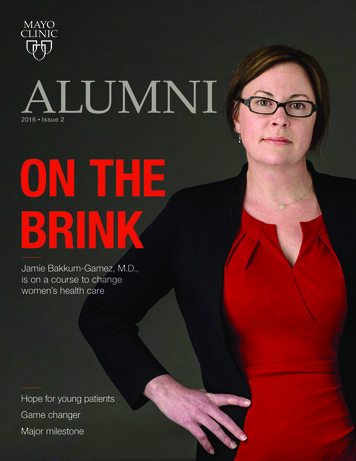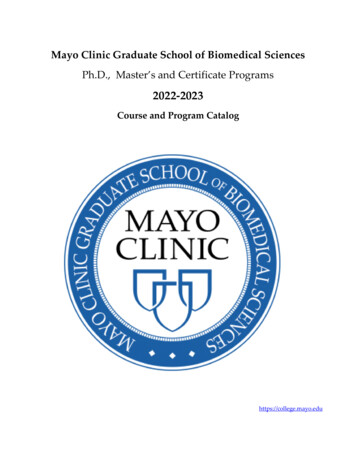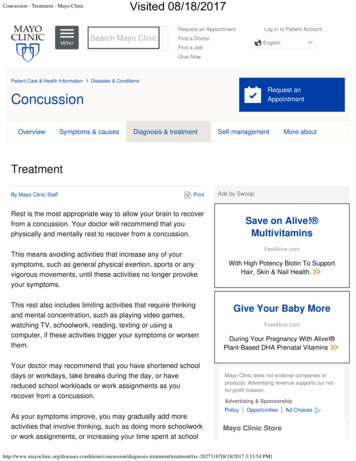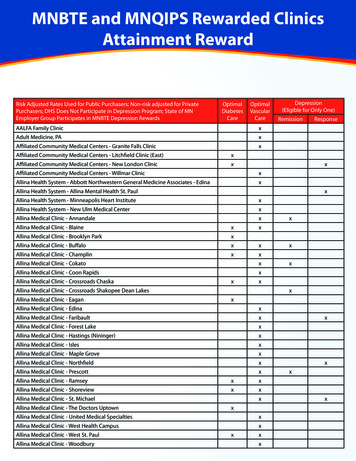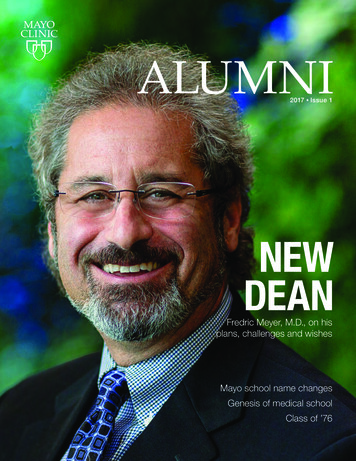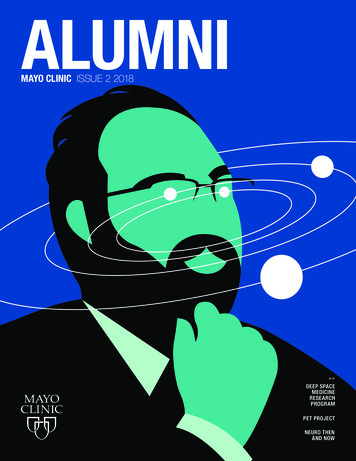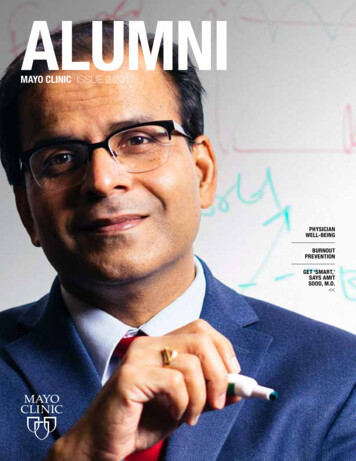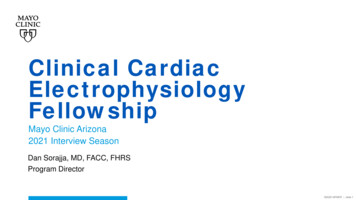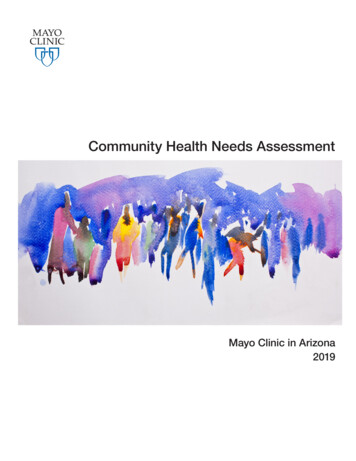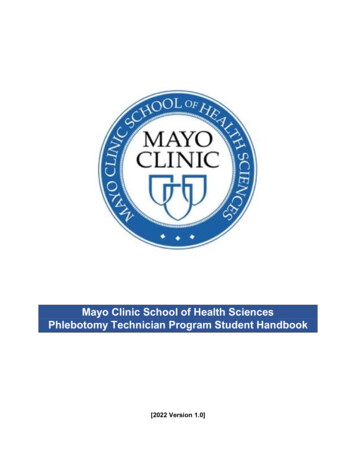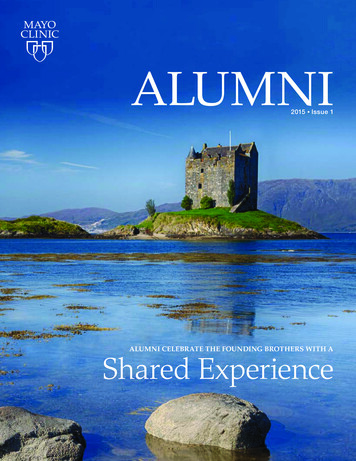
Transcription
ALUMNI2015 Issue 1ALUMNI CELEBRATE THE FOUNDING BROTHERS WITH AShared Experience
CONTENTS2015Issue 12112232FEATURESInternational meeting recap 2Record number gathers in Ireland and ScotlandIreland collaboration 6Visiting resident program attractsexceptional traineesMayo Clinic AlumniAssociation at 100 11Mayo Graduate School25th anniversary 34Symposium features alumni speakersKnow your Boardof Directors 38Profiles of representativesThe CEOs of Mayo Clinic 41Established in a time of great change inmedical practice and educationHistoric gathering of Mayo Clinic leadersOffice of Health DisparitiesResearch 22Mark your calendarAddresses health disparities in researchMayowood restoration 28Safeguarding a historic resourceOn the shoulders of giants 32Influencing the next generationCover photo: Cory Ingram, M.D. (GIM ’14)Biennial program 42Human resources 43Physician and scientist opportunitiesMAYO UPDATE 44New website, new medical director ofAlumni Relations, obituaries
A Letter from the PresidentThe Alumni Associationmarks the 100thanniversary of itsincorporation thisyear. I hope you all will considerattending the 69th BiennialMeeting in Phoenix in October,when we will celebrate thiscentennial. “Coming home” toMayo is a long-standing tradition.In 1930, Dr. Will said the followingto returning alumni:In greeting you, our assistantsof former days . my brother and Itake greater pride in your coming backthan in any other event connectedwith the Clinic.In addition to enjoying fellowshipand learning with those who shareyour common Mayo bonds, you willsee firsthand Mayo Clinic in Arizonaand learn more about programs likethe Proton Beam Therapy Program,which begins seeing patients inspring 2016 (the Proton BeamTherapy Program — Rochestercampus begins seeing patients thissummer) and the Mayo MedicalSchool expansion to Arizona,where the first class will begin in2016 or 2017.Without exception, alumniwho attend the biennial meetingsreconnect with colleagues they didnot anticipate seeing and makenew associations of personal orprofessional merit.To honor our centennial in thismagazine, each of the four 2015issues will feature special contentabout the Alumni Association’s100-year history. This issue coversthe origins through 1940, includingsome remarkable correspondencebetween Dr. Will and early leadersof the Alumni Association, amongothers. I hope you enjoy these gemsas much as I have.Web-only stories1 The Surgeons Club —Physicians who traveled to MayoClinic to watch the Mayo brothersperform surgery beginning in thelate 1890s organized in 1906.Harold Foss, M.D. —The father of the Mayo ClinicAlumni Association was thefounding physician of GeisingerMedical Center and formerpresident of the American Collegeof Surgeons. The Mayo Alumnusprofiled him in 1968 after his death.2Juan Sarmiento, M.D. Associate Director of SurgeryEmory University School of Medicine D irector, HepatopancreaticBiliary Surgery, Emory UniversityHospital, Atlantaalumniassociation.mayo.edu3 Maya Babu, M.D. (NS ’17),a resident in the Department ofNeurologic Surgery at Mayo Clinicin Rochester, was one of the firststudents to participate in a uniquejoint program, simultaneouslyearning her MBA from HarvardBusiness School and her medicaldegree from Harvard MedicalSchool. Learn how she pursuesthe science of medicine, excels inthe art of being a physician leader,and demonstrates the attributesthe Mayo brothers espousedand modeled.123Issue 1 20151
ALUMNI CELEBRATE THE FOUNDING BROTHERS WITH AShared ExperienceIreland-Scotland international Alumni Association meetingdraws a record numberIn September, more than 100 Mayo Clinic alumniplus their guests convened in Dublin, Ireland, andEdinburgh, Scotland, for the 2014 InternationalMayo Clinic Alumni Association Meeting.“The Mayo brothers were famous for visitingmultiple locations on their travels abroad, so wecelebrated their precedent with a two-city meetingin recognition of Mayo Clinic’s sesquicentennial last2MAYO CLINIC ALUMNIyear,” says Michael Sarr, M.D. (GI ’80), Division ofGastroenterologic and General Surgery, Mayo Clinic,James C. Masson Professor of Surgery and meetingco-chair.Attendance was up by 40 percent over the highestattended meeting in recent years (Greece, 2011), andalmost 54 percent of alumni were first-time attendeesat an international Alumni Association meeting.
Photos: Cory Ingram, M.D. (GIM ’14), Eddie Greene, M.D. (NEPH ’00)Content in the interactive, participatory meetingwas broad-based and focused on differences inpractice and philosophy between the United Statesand Europe, and developments at Mayo Clinic —especially regenerative medicine, surgical innovationand individualized medicine.Dr. Sarr comments that the meeting not onlyprovides CME credits but also allows physicians andother providers to interact and socialize with those indifferent disciplines — “productive ground for crossfertilization and new friendships.”“Participants felt that the educational opportunityprovided by the international meeting was excellentand enhanced by the closer networking afforded withothers, both international and American colleagues, whohave ties to Mayo Clinic,” says Deborah Lightner, M.D.(U ’95), Department of Urology, Mayo Clinic, andmeeting co-chair.The location for the June 2016 International MayoClinic Alumni Association Meeting will be announcedearly in 2015 to allow alumni and their families tobegin planning. Issue 1 20153
First-timers share meetingexperienceThe 2014 International Mayo Clinic Alumni AssociationMeeting was a first for more than half of the participants,including including Bhalchandra Parulkar, M.D. (GUP ’88,U ‘89) and his wife, Smita Parulkar, M.D., of Worcester,Massachusetts; and Gregory Peterson, M.D. (I ’83,PMR ’86), and his wife, Lynne Schmid Peterson, M.D.(IM ’93, RHEUM ’96), of Bismarck, North Dakota.They share their experience with Mayo Clinic Alumni.Medical Center in Worcester. Dr. Smita Parulkar is aninternal medical physician who practices at ReliantMedical Group in Worcester.“Medicine is becoming more bureaucratic, andwe are losing free time for personal touch and formeeting and making new friends due to professionalpressures,” he says. “Meetings like these are a perfectincubator for new friendships and connections withMayo faculty. I met doctors from urology faculty fromMayo Clinic in Rochester and Scottsdale to improveBhalchandra Parulkar,‘Meetings like these are a perfect incubator for newfriendships and connections with Mayo faculty’“For the first time in 20 years, my wife and I were ableto attend a meeting where we could both enjoy thecross-specialty presentations, enjoy the conferencevenue and cities, and have time for ourselves to makenew friends,” says Dr. Bhalchandra Parulkar, chiefof urology at Saint Vincent Hospital and assistantprofessor of urology at University of Massachusetts4MAYO CLINIC ALUMNIM.B.B.S., andSmita Parulkar, M.D.
my network. I want to stay connected because MayoClinic training made me what I am today and setmy career path toward a patient-centric focus. I’ma vocal ambassador for the Mayo Clinic model inour community.”The Parulkars had twins while they trained at MayoClinic. Dr. Smita Parulkar had premature contractions andwas hospitalized for four months. “Mayo Clinic admittedher with no consideration for cost, and looked out for herand the babies. We owe a lot to Mayo Clinic. Both our kidsare in medical school at Alpert Medicine School at BrownUniversity,” says Dr. Bhalchandra Parulkar.‘Of special value was renewing my connectionto the people and philosophy of Mayo’“The program looked interesting, with a thoughtfulbalance of education and vacation, and we hadn’tvisited Ireland or Scotland,” says Dr. Greg Peterson, anoutpatient rehabilitation and EMG consultant at SanfordHealth in Bismarck. “My wife, Lynne [also a physician atSanford Health], and I met at Mayo and both love Mayo.Gregory Peterson, M.D.,and Lynne SchmidPeterson, M.D.We didn’t know anyone else who was going, but themeeting environment made socializing very comfortable— something I tend to avoid at meetings.“Two former colleagues were there, unexpectedly,and I made new friends and met people I’d admiredthrough the years. Of special value was renewing myconnection to the people and philosophy of Mayo. Theinternational meeting exceeded my expectations. Itwas a great opportunity to learn and connect withpeople I love and admire.”Issue 1 20155
Visiting resident program attracts‘ CREAM OFTHE CROP’from IrelandInternal medicine trainees from Ireland have aunique opportunity to learn about the Mayo Modelof Care through a six-month visiting residentprogram with the National University of Ireland,Galway (NUIG). Each January and July, tworesidents arrive in Rochester for the program.6MAYO CLINIC ALUMNI
The relationship between Mayo Clinic andNUIG is rooted in Timothy O’Brien, M.D.(ENDO ’93), professor of medicine anddirector of REMEDI (Regenerative MedicineInstitute); dean of the College of Medicine, Nursing andHealth Sciences, NUIG; and consultant endocrinologistat Galway University Hospitals. Dr. O’Brien, whowas on staff at Mayo Clinic for six years, collaboratedwith former director of the Mayo Clinic internalmedicine residency program Joseph Kolars, M.D.(GI ’99) (now senior associate dean for educationand global initiatives at the University of MichiganMedical School), and his successor, Furman McDonald,M.D. (MMS ’97, I ’00, CMR ’01), Division of HospitalInternal Medicine at Mayo Clinic, to develop andnurture the program. Amy Oxentenko, M.D. (I ’01,CMR ’02, GI ’05), Division of Gastroenterology andHepatology, oversees the exchange today as directorof Mayo Clinic’s internal medicine residency program.Seán Dinneen, M.D.(I ’91, ENDO ’94), head ofthe School of Medicine atNUIG and an endocrinologist at Galway UniversityHospitals, says the visitingresident exchange programpositions are highlysought after.“The cream of the cropcompete for this visitingresidency program,” saysDr. Dinneen, who was onstaff at Mayo Clinic for fiveyears. “Mayo has alwaysemphasized the importanceof time at the bedside,Timothy O’Brien, M.D.which resonates with Irishmedical graduates forwhom clinical skills and acumen are very important.Irish physicians who travel to Mayo are very aware ofmaintaining a tradition of excellence, which spurs us toachieve at the highest possible level.”Mayo Clinic Alumni profiles several physicians whoparticipated in the visiting resident program. Irish physicians who travel to Mayo arevery aware of maintaining a tradition ofexcellence, which spurs us to achieveat the highest possible level.”–Seán Dinneen, M.D.Issue 1 20157
Eoin Flanagan, M.B., B.Ch.(I ’09, N ’12, N-MS ’13, N-AI ’14, N-BN ’15)Dr. Flanagan was a visiting resident in 2007 andreturned to Mayo Clinic a year later to complete aresidency in neurology. He is a fellow in behavioralneurology and will join the staff in July 2015.“In Ireland, we focus on clinical skills, but we don’thave as many resources as are available at Mayo Clinic,including research opportunities and quality measures,”says Dr. Flanagan, who is from Dublin. “There’s greatsatisfaction in getting patient investigations performedquickly, which leads to more timely diagnoses. I waspleasantly surprised by the team approach at Mayo.If there’s a problem, you can page a world expert andget answers; such close collaboration ensures patientsget the best care for the problem at hand. Medicine inIreland isn’t organized as well to facilitate that teamwork.“With the excellent clinical training we receive inIreland and strong work ethic, the Irish have done wellat Mayo over the years. This has led to an opennessto recruiting Irish staff to stay on at Mayo. The sixmonth visiting resident program provided me a greatopportunity to start a career at Mayo, and I wasdetermined not to letthat opportunity slipby. With some hardwork and thanks to thefaith put in me by theneurology leadership,I am delighted it hasworked out.”Dr. Flanagan saysthe Irish communityin Rochester welcomesnew Irish recruits,helping to make the transition to life in the UnitedStates seamless. “I was especially lucky to have twoconsultant neurologists at Mayo who are originallyfrom Ireland to help guide and mentor me throughmy neurology training — Dr. Sean Pittock [N ’02,I-1 ’03, N-MS ’04] and Dr. Andrew McKeon [MD ’07,N-AI ’09],” he says.Derek O’Keeffe, M.B., B.Ch., Ph.D.(ENDO ’15)Dr. O’Keeffe completed the exchange program in 2012and was offered a clinical fellowship in endocrinologyat Mayo Clinic.A native of Limerick, Ireland, Dr. O’Keeffe hasan undergraduate degree in electronic engineering, amaster’s degree in computer engineering and a Ph.D. inbiomedical engineering from the University of Limerick.He completed a postdoctoral Fulbright fellowship atHarvard University.Dr. O’Brien encouraged him to combine the studyof medicine and engineering at NUIG and continue thejourney at Mayo Clinic. “Mayo Clinic is a fertile placefor people with imagination and an interest in clinicalinnovation,” says Dr. O’Keeffe.The six-month visiting resident programprovided me a great opportunity to start acareer at Mayo, and I was determined notto let that opportunity slip by.”–Eoin Flanagan, M.B., B.Ch.8MAYO CLINIC ALUMNI
Institutions grow and become strongerwhen they cross-pollinate.”–Derek O’Keeffe, M.B., B.Ch., Ph.D.During his fellowship, he hascontinued biomedical research andwas awarded a Center for Innovation(CFI) technology grant with MayoClinic endocrinologist Yogish Kudva, M.B.B.S. (I ’95,ENDO ’98). “This allowed us to develop a remoteaccess diabetes care platform,” says Dr. O’Keeffe.“A spin-off from this research was the developmentof the necessary software architecture and algorithmsfor big data analysis from the diabetes technology.“Mayo Clinic has a unique spirit. It is a verycollegial ecosystem and, therefore, everyone enjoysworking here. It seamlessly integrates patient care,education and research.”Dr. O’Keeffe points out the importance ofthe Mayo-Galway resident exchange program.“Institutions grow and become stronger when theycross-pollinate,” he says.Dr. O’Keeffe will return to Ireland in June tocomplete his European endocrine clinical trainingand will continue his research in collaboration withhis Mayo Clinic colleagues.Alan Sugrue, M.B., B.Ch. (I ’17)Dr. Sugrue completed the residency exchange in 2013.During his Irish residency, he completed a master’sdegree in translational clinical science and cardiologyat University College London and received an IrishCardiology Young Investigator of the Year (2013)award. He returned to Mayo Clinic in 2014 to completean internal medicine residency and plans to pursue acardiology fellowship.“Mayo is a prestigious institution, and I am gratefulto be here and to work with world leaders in a differentculture and health care system,” he says. “While thereare no doubts about Mayo’s world-class facilities, itwas the people who work here, the outstanding workenvironment, and the ability to develop and performresearch that attracted me to return.“Coming to Mayo has given me endless opportunitiesto grow, learn and improve my research methods andclinical practice. I want to continue to grow and developas a physician and researcher at Mayo Clinic and, possiblyin 15 or so years, take this solid foundation back toIreland to stimulate and encourage the next generationof young doctors.” I want to continue to grow anddevelop as a physician and researcherat Mayo Clinic and, possibly in 15 or soyears, take this solid foundation backto Ireland to stimulate and encouragethe next generation of young doctors.”–Alan Sugrue, M.B., B.Ch.Issue 1 20159
Multifaceted collaborationsunderway with IrelandMayo Clinic’s exchanges with Ireland involve morethan just residents. Significant business exchangealso is underway.Enterprise IrelandIn April 2014, Mayo Clinic announced a five-yearagreement with Enterprise Ireland, the Irish enterprisedevelopment agency.The Irish government will provide up to 16.5 millionfor the codevelopment and licensing of novel medicaltechnologies from Mayo Clinic that will be furtherdeveloped and validated by research teams in Irishhigher education institutions. Enterprise Ireland alsowill introduce these technologies — that have highpotential to diagnose or treat patients — to investors.“This collaboration bridges a financial gap fortranslational research and provides funding in betweenthe early-stage basic research and the stage when aAccording to Taoiseach Enda Kenny (back, center), prime minister of Ireland,the agreement builds on an Irish connection with Mayo Clinic that extends backto the 19th century, when the Mayo brothers learned from the work of membersof the Royal College of Surgeons. Among those pictured with Prime MinisterKenny is Mayo Clinic Chief Administrative Officer Jeff Bolton (front, left).10MAYO CLINIC ALUMNItechnology is ready for the marketplace,” says GregoryGores, M.D. (GI ’85), the Mr. and Mrs. Ronald F. KinneyExecutive Dean for Research honoring Ronald F. Kinney,Jr., and Reuben R. Eisenberg Professor at Mayo Clinic. “Inthe United States, this stage is expensive and difficult tofund. We are providing the technologies, and EnterpriseIreland the funding. Together, we are advancingtechnology that has a high potential to make a differencein patient care and alleviate the burdens of disease.”Development of a device to treat atrial fibrillation isalready underway at NUIG. The device was developed bySamuel Asirvatham, M.D. (CV-EP ’00), a cardiac electrophysiologist at Mayo Clinic. The plan calls for NUIG toconduct the preclinical work necessary to support humanclinical trials, validate the market and reimbursementmodel for the device, and support the exploration of thecommercial potential of the technology in Ireland.“This deal will seed as many as 10 ‘spin-out’companies in Ireland while bringing advanced medicaltechnologies to patients and providing a revenuestream back to Mayo Clinic to enhance its mission,”says Keith O’Neill, Ph.D., director of lifesciencescommercialisation, Enterprise Ireland. “We look forwardto working with Mayo Clinic to create new companiesand jobs around these world-class technologies.”National University of Irelandmemorandum of understandingIn August 2014, Mayo Clinic signed a memorandum ofunderstanding with the National University of Ireland,Galway (NUIG) to pave the way for joint clinical trialsusing regenerative therapies. Specifically, the MayoClinic Center for Regenerative Medicine and NUIG’sRegenerative Medicine Institute (REMEDI) and theNetwork of Excellence for Functional Biomaterialswill focus on adult stem cell therapy, gene therapy,biomaterials and biomedical engineering.The U.S. Food and Drug Administration andEuropean Medicines Agency are attempting tostreamline and facilitate introduction of new therapieson both sides of the Atlantic Ocean.“Sharing experience through international collaborations fosters advances in this emerging field of science ofmedicine and facilitates more rapid introduction of therapies for patients,” says Andre Terzic, M.D., Ph.D. (CV ’92),the Michael S. and Mary Sue Shannon Family Director,Mayo Clinic Center for Regenerative Medicine andMarriott Family Professor of Cardiovascular Research.
THE ALUMNIASSOCIATIONThe first quarter-centuryThe Mayo Clinic Alumni Association marks its 100thanniversary in 2015. Each of the four issues of Mayo ClinicAlumni magazine in 2015 will include special content aboutthe Alumni Association, one quarter-century at a time.This issue focuses on the early years of Mayo Clinic,when the Alumni Association was established in a timeof great change in medical practice and education.11
THE BEGINNINGMayo Clinic pioneers had great aspirations for theAssociation of Resident and Ex-Resident Physicians of theMayo Clinic (now the Mayo Clinic Alumni Association).In 1921 at the six-year-old Alumni Association’s annualbanquet, Charles H. Mayo, M.D., shared his thoughts aboutthe group’s benefits for members and for medicine:Already by that time, Mayo Clinic had more thantwo decades of “grouping together of men” in theexchange of experiences and ideals. Physicians flockedto Rochester from around the world to learn, watchsurgical procedures and share their observations.Associations of this character are very useful. Itmeans the grouping together of men who are friends,who have had the same opportunities, and the samekeen incentives to stimulate them in their field ofwork. In meeting here every year, the stimulusand the incentive are renewed in the interchangeof experiences and ideals. And each year astime ripens your judgment and increasesthe membership of the Association thebroader, better work spreads intobroader and more distant fields.WilliamMayo, M.D.CharlesMayo, M.D.1890s:Physiciansbegan travelingto Rochester toobserve the Mayobrothers performsurgery.THE EARLY1890–1940YEARS121890s
THE FORCE BEHIND THE ALUMNI ASSOCIATIONChief among the pioneers and the force behind theAlumni Association was Harold Foss, M.D., foundingphysician of Geisinger Medical Center in Danville,Pennsylvania. A 1968 Mayo Alumnus magazineposthumous tribute to Dr. Foss — the first president ofthe Alumni Association — referred to him as the fatherof the Mayo Clinic Alumni Association and “a DoctorWill kind of man,” who patterned his professional lifeand that of his institution on the example of his formerteacher and friend — the elder Mayo brother.Dr. Foss, a fellow (resident) in surgery in 1915,proposed the formation of an association comprisedof members of the Mayo Clinic staff and physicianswho had served at least one year in Rochester andnow practiced in other parts of the country.A committee that included Dr. Foss, EgertonCrispin, M.D., Arch Logan, M.D., Robert Mussey, M.D.,and Albert Miller, M.D., drafted a constitution for theAssociation of Resident and Ex-Resident Physicians ofthe Mayo Clinic. The chief purpose of the group was “toestablish a closer and more definite social and scientificrelationship between these individuals and the Clinic.”1911: Mayo Clinic beganhaving surgical interns foryearlong or longer stintsand established formalspecialty training programsat the instigation of HenryPlummer, M.D.1906: TheInternationalSurgeons Clubwas formed.1906HenryPlummer, M.D.191113
1915 Mayo Foundationfor Medical Education andResearch medallion.In 1919, Dr. Foss, then practicing in Danville, said in his first presidential address:More than seventy-five men haveworked in the Mayo Clinic and haveleft to practice their profession invarious parts of the world. It nowseems fitting that these men shouldbind themselves together into anassociation. . Is it presumptuousto expect that from these studentsof today will come some of the greatleaders of tomorrow may notsome of those who are to direct thethoughts of American medicine inthe future have as their proudestboast that they had been pupilsof the Mayos?It is our hope that this Associationwill in time become of nationalimportance and a power in theadvancement of Americanmedicine. Its obligations are boundto be tremendous for as loyalalumni the duty falls on us ofcarrying accurately into everydistrict of the land the teachings ofthe Clinic from which some of thegreatest developments in Americanmedicine and surgery are coming.1915: Harold Foss, M.D., proposed theformation of an association comprisedof members of the Mayo Clinic staff andphysicians who had served at least oneyear in Rochester and now practicedin other parts of the country. Theassociation was incorporated withthe state of Minnesota.James Masson, M.D.President George Vincent visited MayoClinic, learned about the postgraduateprograms and pursued an associationbetween the two institutions.1419111915: Mayo Clinic formed a newentity, the Mayo Foundation for MedicalEducation and Research to facilitate thelegalities necessary for the universityaffiliation, and donated 1.5 million tothe university.Melvin Henderson, M.D.George VincentHarold Foss, M.D.1911: University of MinnesotaThis association has been formedfor the loyal alumnus, the man (orwoman) who appreciates the honorof having been a Mayo Clinic man,and who consecrates his life for theprincipal for which it stands, theman who has acquired the idealsof the Clinic, and who feels a deepsense of gratitude to those who havebeen his teachers, and whom he hasto thank for much of the success thatis to come to him in life.Stuart Harrington, M.D.Donald Balfour, M.D.John Pemberton, M.D.1915
MAYO BROTHERS’ HANDS-ONINVOLVEMENT IN NEW GROUPCorrespondence between Dr. Foss and William J. Mayo, M.D., as well as Dr. Will’s missives to others,convey the Mayo brothers’ hands-on involvement and keen interest in Dr. Foss’s fledgling group:I think the organization is a splendidthing; I am very happy over it, andanything I can do at any time topromote its interests will be mostcheerfully done.I want to tell you what a satisfactionyour interest in the AlumniAssociation is to Dr. Charlie andmyself and other members of thestaff. We will try in the future as inthe past to make it something all theboys will be proud of. I have beenwondering whether it would notbe a good plan to form a committeeof alumni as an advisory board,to whom each year our problemscould be presented for their advice.We should derive great benefit fromthe men who have the future somuch at heart.Dr. Will Mayo to Dr. Foss,Feb. 22, 1917I am very glad you so heartilyendorse this movement. I feel thatthe organization is a most excellentthing for the Clinic, as well as theAlumni, and, it is my hope that wewill rapidly develop a spirit ofenthusiasm and loyalty whichwill be as great, if not greater than,that of any University Alumni bodyin the country.Dr. Will Mayo to Dr. Foss,June 1, 1922Dr. Foss to Dr. Will Mayo,Feb. 26, 1917Dr. Will Mayo to membersof the Association of Residentand Ex-Resident Physicians,March 15, 19331917: Dr. Will spoke before theMinnesota state legislature to protesta bill to dissolve the agreementbetween the university and MayoClinic. Afterward, the legislatureunanimously passed the affiliation bill.William Mayo, M.D.Our president [Alumni Associationpresident Clyde Roeder, M.D.] isill, and unable to carry on thepresidential work connected withthe coming meeting, so that makes usall responsible to see that this meetingwill be the best one we ever have had.Let us look up our interesting work,not the unusual or the unnatural, butthe interesting and instructive work,and present it at this meeting.Always remember that to have our“old boys” come back is, to us, likehaving our families come home; wewill be here to welcome you.1917: The first meetings of the alumniassociation were on Sept. 4 and 5, 1917.Elected officers were Harold Foss, M.D.,president; Donald Balfour, M.D., vicepresident; William Carroll, M.D., secretary;Arthur Sanford, M.D., treasurer. Membersof the Board of Governors were E. StarrJudd, M.D., William Braasch, M.D., andOtis Lamson, M.D.1917: Fellows (residents) of MayoClinic became enrolled in the GraduateSchool of the University of Minnesota;the first graduate degrees wereawarded to four Mayo fellows.William Carroll, M.D.Harold Foss, M.D.1917Donald Balfour, M.D.Arthur Sanford, M.D.15
ALUMNI ROLE IN DISSEMINATINGMAYO MODEL OF CAREDr. Charlie mentioned the Alumni Association as animpetus for spreading better work into broader and moredistant fields. Certainly, Dr. Foss and other early leadersof the group were influential in disseminating the MayoModel of Care in medical institutions across the country.Alumni Association presidents Dr. Foss, DonaldGuthrie, M.D., and William Estes Jr., M.D. — alongwith the Mayo brothers — were fellows of the AmericanCollege of Surgeons. Dr. Guthrie started the RobertPacker Hospital (today, the Guthrie Robert PackerHospital) in Sayre, Pennsylvania. Dr. Estes wasappointed medical advisor to Lehigh Universityand chief of staff of St. Luke’s Hospital — both inBethlehem, Pennsylvania. Another association president,Stanley Seeger, M.D., also a member of the AmericanCollege of Surgeons, became chief of staff at ColumbiaHospital in Milwaukee (today, Columbia St. Mary’s).Outreach and fellowship by early Mayo staffmembers and trainees ensured that the organization’sreach extended beyond institutions led by its alumni.Appreciation and exchange of ideas and talentis evident in the personal and highly personablecorrespondence between Mayo pioneers and leadersof major medical centers:Henry Plummer, M.D.Harold Foss, M.D.President 1917-1919E. Starr Judd, M.D.1918: The Mayo AlumniFund was started with a giftof 50 from Harold Foss,M.D. The fund was intendedto assist projects notincluded in the general fund,including support of medicalstudent clerkships and MayoMedical School students.The Judd-Plummer Fundand Donald C. Balfour Fundswere amalgamated into theMayo Alumni Fund of theAlumni Association.Donald Balfour, M.D.161918
It has come to the attention of themembers of the Medical GraduateCommittee of the Foundation thatyou will be in St. Paul for the meetingof the Inter-State Post-GraduateMedical Association next month.The members of the Committeewould like very much to invite youto visit during your stay inMinnesota, and if convenient givea talk to the staff of the Clinic andfellows of the Foundation on somesubject of your selection. You havemany friends among the staff of theClinic who would like very much tosee you and hear of your latest ideas,and the Fellows would regard it avery unusual opportunity.Louis Wilson, M.D., toGeorge Crile, M.D., co-founder,Cleveland Clinic,Sept. 29, 1936I am writing you concerning aDr. Samuel Standard of New York,who is at present in Rochester.Dr. Standard is connected with theSurgical Service of Bellevue underDr. Wright. Dr. Wright isconsidering the establishmentof a Gastro-intestinal Service atBellevue, and Dr. Standard is atRochester to see the general routine
Internal Medicine at Mayo Clinic, to develop and nurture the program. Amy Oxentenko, M.D. (I '01, CMR '02, GI '05), Division of Gastroenterology and Hepatology, oversees the exchange today as director of Mayo Clinic's internal medicine residency program. Seán Dinneen, M.D. (I '91, ENDO '94), head of the School of Medicine at
